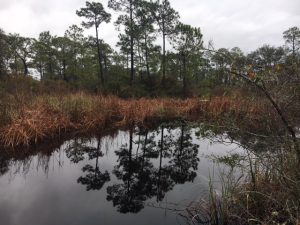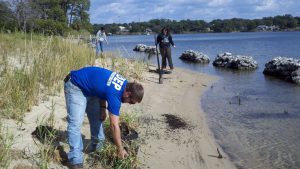In this series of restoring the health of the Pensacola Bay System, we are not only focusing on the status of the bay but what citizens can do to help improve things. If you are a waterfront property owner, one of the things you can do is plant a living shoreline.

Photo: Rick O’Connor
What is a Living Shoreline?
A living shoreline is one that has native plants growing along the shoreline within zones of where mother nature would have done so herself. Before humans began developing our shorelines, the high ground would have had a mixture of woodlands and open fields – depending on the topography, soil, and ability to hold water for a period of time. Along our bayous, there would have been some stands of pine and others of live oaks. Leaf litter would have been common and, in more open areas, grasses and legumes would have done well. Along the water’s edge where the wave energy was relatively low, marshes would have been common. Up the rivers and creeks, cypress swamps would have been more common, but in the estuarine areas, marshes would have been the rule. The type of grass found in these marshes would vary depending on the salinity of the body of water.
These marshes are excellent at absorbing wave energy and reducing the erosion of the shoreline. They would have captured much of the rainwater runoff (what the upland forest did not already capture) and filtered much of the sediment from entering the bay. The water clarity would have allowed seagrasses to grow in the offshore regions, and the marshes would have provided one other service – supporting an abundance of wildlife and fisheries. It is known today that 80-90% of the economically important marine species use these marshes at least part of their life cycle.
And then we came along…

Photo: Rick O’Connor
At first, humans were not interested in living right on the water’s edge, there were flooding issues during storms – but we got over that. It was important to have port businesses close to the water’s edge in the early days, but people built their homes on the “hill” – North Hill and East Hill in Pensacola. We did have small homes near some of the bayous – again off the water’s edge – but by the mid twentieth century, the waterfront home boom was on. Quickly, new developments began to spring up along our bayous, removing much of the natural vegetation along the shoreline to provide access to the water for recreation. The marshes were seen as mosquito farms and snake dens so were removed. This allowed lawn grass to be planted to the shoreline and a nice beach for families to enjoy.
With the loss of woodlands and marshes, the runoff began to increase into the bayous and the bay. Stormwater projects were built to divert rainwater off streets and lawns, discharging into the waterways. Many of the lawns were of turf that were not local to the area, thus fertilizers and pesticides had to be applied to keep them looking good – all of this entered the waterways.
Some of the old-timers remember when the changes began. First, the turbidity increased and the seagrasses began to decline. Without the marsh, shoreline erosion increased, particularly during storms, and so seawalls were installed to save them (beach armoring we call it now). The seawalls increased the natural wave energy with reflection off the wall meeting on coming waves – further increasing erosion on either side of the wall and the loss of much needed seagrasses. With the increase in turbidity and decrease of seagrasses, the old-timers mentioned they began to see the decline of certain species in the bayous.
The increase in boating did not help. Docks had to be built and boat wake increased wave energy even further. By the 1970’s people began to notice the impacts of all of this. Fish kills were becoming more common and in some cases, literally millions of fish could be found dead at the surface and on these beaches. The waters were murky and the seagrasses were gone from many areas.

Photo: Rick O’Connor
A living shoreline then, is a practice of trying to restore the natural shoreline to its original form to counter the above. Not all locations along the Pensacola Bay System (PBS) are suitable for such a project. Marshes require low wave energy environments; some of the shoreline of our bay is open water – a large fetch – and would not have supported marshes anyway. However, where they would have grown, a living shoreline is a good method to help improve the overall health of the bay. They reduce erosion and stormwater runoff, as well as enhance wildlife and fisheries.
So How Do I Get a Living Shoreline?
Step 1 – is to determine if a marsh will work on your shoreline. You can contact Florida Department of Environmental Protection, the Bream Fishermen Association, or the County Extension office for assistance.
Step 2 – decide what plants and where you plan to plant. Submerged land below the mean high tide line (where portions of the marsh would grow) belongs to the state of Florida. To plant here will require a permit. The organizations above have a brochure to help the homeowner navigate the permit process. Small projects are relatively easy to do.

Photo: FDEP
Step 3 – right plant in the right place. With assistance from the above agencies, the homeowner can map out which plants they would like to plant in their living shoreline. Depending on the location of the shore, there are recommended plants for particular zones. There are several nurseries in the area that provide these plants, and some will assist with the planting.
Step 4 – monitoring the project. It is good to monitor the project to determine if things are working and adjust if not. The County Extension office can train you on how to do this and provide some of the needed materials and supplies.

Photo: Charlie Lurton
With installment of a living shoreline, and the use of Florida Friendly Landscaping practices, waterfront homeowners can significantly reduce their impact on the bay and help improve the overall health.
For more information on the putting in a living shoreline, contact your county Sea Grant Agent at the local county extension office.
 0
0
